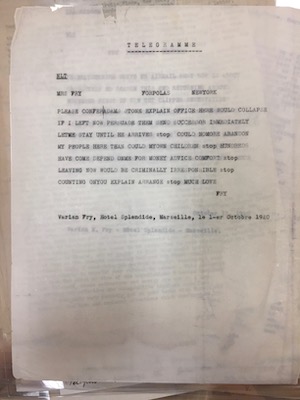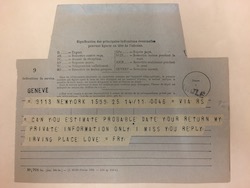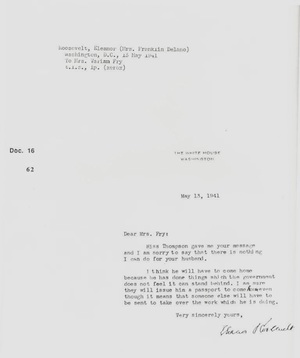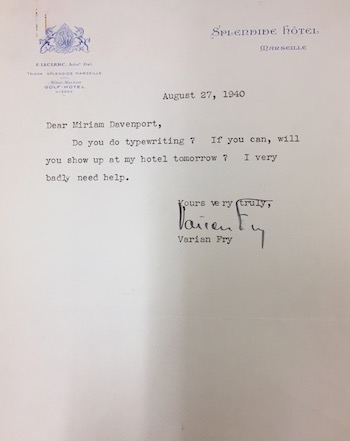VARIAN FRY: SELECTED DOCUMENTS
A letter from Varian Fry to Miriam Davenport
Aug 27, 1940
Miriam Davenport, a young American art historian who had studied at the Sorbonne, became one of Fry’s closest associates in his lifesaving work in Marseille. This was the letter he sent to recruit her to his mission. Her role ended up going far beyond typewriting: among other duties, she interviewed refugees to determine whether the Emergency Rescue Committee should accept them as clients and help them leave France.

Cable from Varian Fry to his wife Eileen
Oct 1, 1940
Eileen Fry, a former editor at the Atlantic Monthly and a Latin professor at the Brearley School, knew her husband was in danger and implored him to come home. In this cable, Fry argues the moral impossibility of leaving his work unfinished: “Office here would collapse if I left now…could no more abandon my people here than my own children.”

Letter to Eileen Fry
Oct 27, 1940
In this excerpt from a fourteen-page letter to Eileen, Fry describes his work in Marseille: the interminable hours, the refugees waiting at all hours outside his hotel room, his own state of nervous exhaustion, the nightmarish political situation, and the difficulty of getting the New York office of the Emergency Rescue Committee to understand how dire the situation was on the ground: “Are they really interested in doing something to rescue what is left of European culture before it is too late?”

Letter to Eileen
October 31, 1940
In this letter, an apologetic response to a note from Eileen, V.F. concedes that he shares at least some responsibility for the New York office’s insensitivity to his mission’s needs. He hasn’t been communicating clearly enough, he writes—“I have allowed myself to forget how little everyone in the US knows about the situation here”—and vows to do better in the future. He goes on to refute claims by the French authorities that members of his staff have been conducting refugees over the border illegally (this last was probably for the benefit of the censors, as the claims were in fact true).

A cable from Eileen
November 14, 1940
By this time, V.F. had been in France since August—three times as long as his original projection—and there was no indication that his work might be drawing to a close anytime soon, nor that he had any intention of returning to New York before it did.

Letter to Eileen Fry about Imprisonment on the Sinaïa
December 8, 1940
V.F.’s arrest came just before Maréchal Pétain, chief of state of Vichy France, made a visit to Marseille. V.F. describes how police arrived at the Villa Air Bel, where he was living with his associates and his surrealist clients, and searched the house from floor to attic for evidence of communist activity. Then Fry and his clients were loaded into black marias and transported to police headquarters. After a few hours, the detainees were transferred to the Sinaïa and held there for three days, sleeping on straw-filled burlap mattresses and waiting for information as to why they’d been arrested and when they might be released.

Letter to Eileen Fry from Eleanor Roosevelt
May 13, 1941
After nine months the U.S. State Department and the French government had both lost patience with Fry, who had regularly been breaking French laws to save his clients’ lives. Eileen Fry appealed to Mrs. Roosevelt for the government’s support, but Roosevelt replied that she thought V.F. would have to come home “because he has done things which the government does not feel it can stand behind.”
